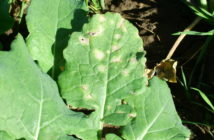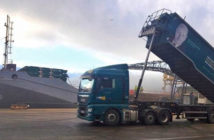New recommendations to help growers optimise Amistar in-furrow applications may soon be on the way, reported Syngenta technical manager Michael Tait, speaking at this year’s Potatoes in Practice (8 August 2019).
Displaying a new design of planter nozzle set up at the Dundee event, he highlighted previous models had cone nozzles built in at both front and back of the shoe. That design sprayed into the furrow as it was opened, before placing the seed potato, and again onto the soil as the tuber was covered. However, feedback from growers had pointed out that the front nozzle could be prone to clogging with soil.
The new design, instigated by Syngenta, Team Sprayers and Grimme, has come up with a configuration that has both nozzles strategically placed to spray and mix into the soil after the potato has been planted.
“We have been doing intensive testing to see whether hollow cone or low drift nozzles work best for application, and what are the optimum water volumes?” said Michael. “Particularly on modern belt planters operating at higher speeds.
“Previously planters were typically smaller and slower, standard practice was to recommend the minimum possible water volumes. It was often a trade-off of the need for efficacy, with the capability of machinery,” he pointed out.
“Today’s machines are bigger and faster, with the capacity to carry more and with growers geared up to efficiency of operations to get the best possible results. With the ability to apply at a water volume of 100 l/ha, we can potentially move towards optimum efficacy.”
After application trials with the new equipment at the start of the season, they have been assessing effects of different techniques on emergence and ground cover, as well as monitoring disease throughout the season.
Data from independent VCS trials on rhizoctonia control should be available for BP2019 at Harrogate, whilst reports on diseases which develop over time in storage, such as black dot, will be released at next year’s Potato Science meetings, Michael advised.
“Our intention is to improve disease control by working with machinery specialists and evolving growers’ recommendations, to achieve the best possible disease control in practice.”




